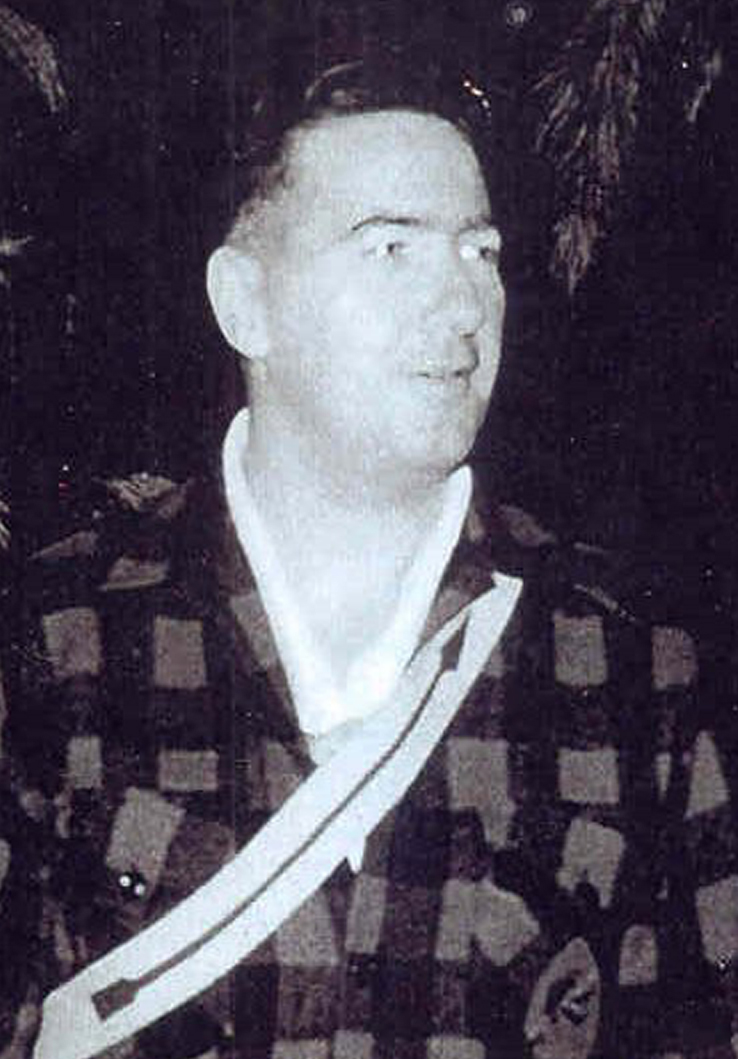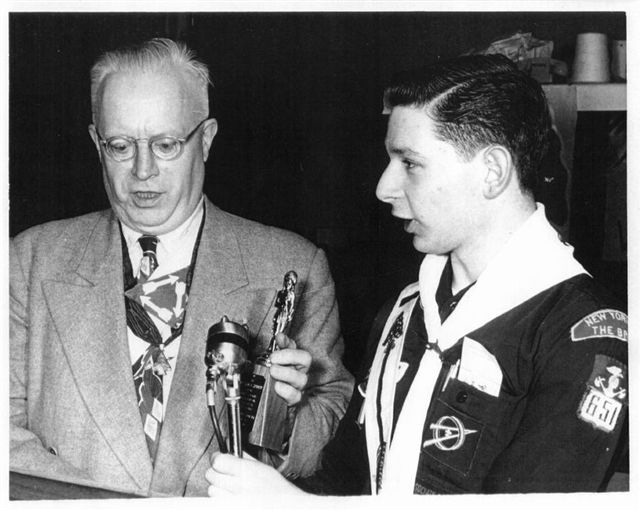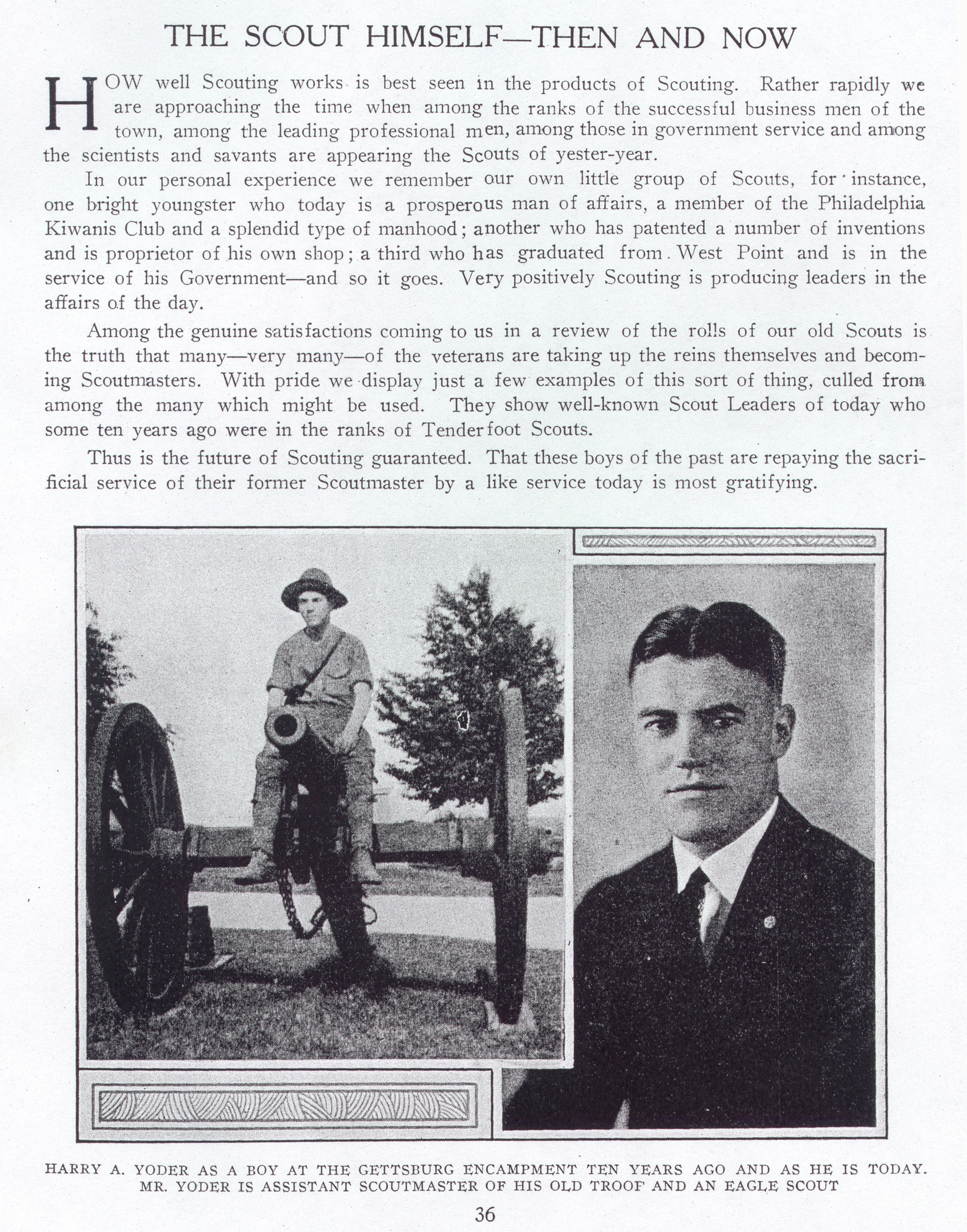National Bonnets
The original golden eagle feather bonnet worn and passed down by the national chiefs of the Order of the Arrow (OA) was made in 1938 by members of Anicus Lodge, East Boroughs Council located in Wilkinsburg, Pennsylvania. Former Anicus Lodge Chief, Joseph A. Brunton, Jr. was the first chief to wear the bonnet. He had recently been elected chief of the National Lodge at the twelfth National Lodge Meeting hosted by Shawnee Lodge 51 at Irondale Scout Reservation located in Irondale, Missouri. Subsequently, Anicus Lodge presented this bonnet to the National Lodge of the Order of the Arrow in 1940 when they hosted the Order of the Arrow’s 25th Anniversary meeting at Camp Twin Echo, located near Ligonier, PA. Chief Brunton was the host council’s Scout Executive at the 25th Anniversary meeting and it was Brunton that ceremoniously passed the bonnet to the newly elected National Chief, George Mozealous of Owasippe Lodge. The ceremonious passing of the bonnet is a tradition that still continues to this day.
Like many of the bonnets of that era, the original bonnet was made from authentic eagle feathers. The U.S. Fish and Wildlife Service consider today, both golden and bald eagles threatened species, and federal law now protects the feathers and body parts from these species. The laws regarding the possession or trade of feathers and body parts from these species are both promulgated and enforced by the U.S. Fish and Wildlife Service, and now require a special permit. However, the original bonnet was in the BSA / OA’s possession before such laws were enacted, and therefore no special permit was required to maintain legal ownership.
The original bonnet was used ceremoniously by the Order of the Arrow for its national chief for over 40 years. The national chief at the opening and closing shows of National Order of the Arrow Conferences (NOAC) typically wore the bonnet. The bonnet was also worn at National Planning Meetings following national officer elections. The bonnet was also occasionally worn or displayed at other national events to promote the Order of the Arrow. The original bonnet was used continuously during this time even after the National OA Committee issued its policy known as the “Protected Feather Clarifications” effective January 1, 1976. This policy, which was heavily encouraged by the U.S. Fish and Wildlife Service, prohibited the use of animal parts in the construction of Native American regalia used at Scouting events. However, the U.S. Fish and Wildlife Service made an allowance for the use of the original bonnet by the national chief of the Order of the Arrow.
Tragically, the original bonnet was destroyed in a fire that occurred at the BSA’s national office in Irving, Texas on November 6, 1980. A young security guard whose intention was to be the ‘big hero’ by discovering and putting out the fire deliberately set the blaze. Unfortunately, the fire quickly got out of his control into an area that housed many of the OA’s records and memorabilia, including the original national chief’s bonnet.
After the loss of the original bonnet, the National OA Committee announced that it had decided to construct two new replacement bonnets for its national officers, which for the first time would include a bonnet for the national vice chief. However, due to the passing of federal laws against the sale, trade, or possession of authentic eagle feathers and body parts since the original bonnet was made, any creation of replacement bonnets consisting of such material would typically have been prohibited without a special federal permit for organizations other than those of Native American origin.
In an attempt to remedy the situation, National OA Committee member Don Thom made an offer at the December 1980 National Planning Meeting to disassemble an authentic eagle feather dance bustle that he had in his possession for use in constructing the new replacement bonnets. This generous offer, as well as other possible solutions, was the subject of much discussion by the National OA Committee over the following several months. However, even though these discussions eventually proved to be successful in finding a permanent solution, the Order of the Arrow was still currently without a bonnet for its national chief. In addition, the National OA Committee was facing an immediate dilemma as to what bonnet the national chief might use at the upcoming 1981 National Order of the Arrow Conference being held at the University of Texas at Austin. As a possible solution for this pending dilemma, OA National Secretary William F. “Bill” Downs suggested that a bonnet worthy of use by the National Chief at the upcoming 1981 NOAC be identified from the local area. Once identified, arrangements could be made to temporarily borrow the bonnet for the conference. Remarkably, just such a bonnet was located, and the 1981 OA National Chief Bradley D. Starr subsequently wore it for this event.
The U.S. Fish and Wildlife Service were made aware of the BSA / OA’s unique situation by Walter Wenzel (BSA’s Director of Conservation and former Interior Department employee), and they eagerly came to their aid for a permanent bonnet solution. After first confirming the fact that the original bonnet was made with authentic eagle feathers that were obtained prior to the enactment of such prohibitive laws, they allowed for the replacement of the original bonnet with two new ones constructed of a similar nature. Each of the two replacement bonnets were constructed using 32 authentic golden eagle feathers, tipped with owl feathers. The feathers were provided by the U.S. Fish and Wildlife Service, and came in the form of two crudely constructed, eagle feather bonnets. These bonnets had been in someone’s illegal possession, and had been confiscated in Idaho by federal law enforcement agents. Although the confiscated bonnets were crudely made, the golden eagle feathers that they each contained were absolutely beautiful.
The U.S. Fish and Wildlife Service offered these bonnets to the BSA / OA for use in constructing the two new replacement bonnets via a special permit / loan agreement for scientific and educational purposes. It was signed on May 7, 1982 on behalf of the Boy Scouts of America / Order of the Arrow by Bill Downs (OA National Secretary) and on behalf of the U.S. Fish and Wildlife Service by Gust J. Nun (Special Agent in charge of law enforcement – District 6). This special permit / loan agreement became effective on May 12, 1982, and it has never been revoked. Additionally, the U.S. Fish and Wildlife Service required that a sign indicating that the possession and exhibition of these items were by their permission should accompany any display of these bonnets.
With a supply of authentic golden eagle feathers now legally in hand, the National OA Committee set out to find a craftsman who was an expert in authentic Native American regalia. They discovered and subsequently commissioned Ed Benz of Borger, Texas to construct the two new replacement bonnets. Mr. Benz was an Eagle Scout and former OA region chief (Region 9A). He was also a well known Native American regalia designer and craftsman. Once Mr. Benz was in receipt of the confiscated bonnets, he worked diligently over the next several months to use their feathers to construct the two new replacement bonnets. Mr. Benz completed the bonnets sometime late in 1982, and he delivered them to Bill Downs on December 15th of that same year. National Chief Robert A. Wade and National Vice Chief William B. O’Tuel first wore the new replacement bonnets at the National Planning Meeting in December of 1982, and subsequently at the 1983 National OA Conference held at Rutgers University located in New Brunswick, New Jersey. Of special note: the National OA Committee attached a yellow memorial ribbon to the bonnet of the national vice chief in memory of Josh Sain. Josh was serving as the national vice chief when he was tragically killed in an auto accident on October 24, 1997. The memorial ribbon is a permanent reminder of Josh’s cheerful service, and his life long dedication to servant leadership.
The national chief and vice chief ceremoniously used the replacement bonnets on a regular basis for over 20 years. However, in keeping with its “Protected Feather Clarifications” policy, the National OA Committee decided to retire the authentic golden eagle feather bonnets and to acquire new bonnets for the national chief and vice chief that were made from imitation eagle feathers. In keeping with tradition, it was decided that the new bonnets had to be exact replicas of the retired bonnets. The construction of these replica bonnets was assigned to Ron Bell and Wayne Dukes of the National OA Committee. These two Arrowmen were also Lead Advisers with American Indian Events (AIE). Ron was tasked with creating the beadwork and Wayne was tasked with the bonnet’s feather construction. To assist them in their work, they both had requested photographs of the retired bonnets in order to replicate their designs down to the smallest detail. Ron and Wayne collectively spent countless hours of extremely meticulous work to produce the replica bonnets that are still in use today. The retired bonnets were last used by the National Chief Jeff Hayward and National Vice Chief David Dowty at the 2004 National Order of the Arrow Conference held at Iowa State University, located in Ames, Iowa. In addition, the new replica bonnets were first used by the National Chief Sean Murray and Vice Chief Christopher Schildknecht at the National Planning Meeting in December of 2005, and subsequently by them at the at the 2006 National Order of the Arrow Conference held at Michigan State University located in Ann Arbor, Michigan.
The authentic golden eagle feather bonnets that were created as replacements for the original bonnet are themselves now treated as historical artifacts of the OA and are still on permanent loan to the BSA / OA. These bonnets are placed on permanent display at the National Scouting Museum in Irving, Texas.
1, National Event, OA, Profile, Scouting


